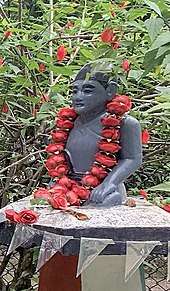Ghansi
Ghansi or Ghasi (Nepali: घाँसी) was a Nepali grasscutter who is best remembered for inspiring Bhanubhakta Acharya to translate the Sanskrit epic Ramayana into the Nepali language. He made money by cutting grass and selling it. Ghansi built a well in order to be remembered after his death. Not much is known about him except that he belonged to the Pantha caste and lived near the well. He has been portrayed by multiple actors in film, and the tourist destination Ghansikuwa was named after him.

Life
One day, as Bhanubhakta Acharya sat on a stone slab in an unfrequented forest, he fell asleep while listening to birds chirping.[1] When he awoke, he saw a person cutting grass. Acharya asked him about his whereabouts and Ghansi replied that he was a poor farmer who lived next to Acharya's village.[1] He made money by cutting grass and selling it in the market.[1] Ghansi told Acharya about his plan to build a well so that passers-by could be refreshed, and he could be remembered after his death.[2][3][4]
His words had a great impact on Acharya, who wrote in a poem that the "grasscutter has taught me a great lesson", and he is credited as one of the inspirations for Acharya's translation of the Sanskrit epic Ramayana into the Nepali language.[1][5][6][7]
भर् जन्म घाँस तिर मन् दिई धन कमायो |
Devoting his life to cutting grass, he earned some money, and wishing to be remembered dug a well. |
| —Ghasi — Bhanubhakta Acharya[8] | —Don Messerschmid, Gautam Yadama, Bhuvan Silwal[9] |
Ghansi built Ghasi Kuwa in Vyas Municipality near the Prithvi Highway.[5] The well is awaiting preservation.[5] According to the Bhanu Ghansi Memorial Park Conservation Committee, Ghansi belonged to the Pantha caste and lived near the well which he constructed.[5] They added it was difficult to identify him due to Acharya not mentioning his name in his writings.[5]
Legacy
Ghansi was portrayed in several films. In Aadi Kabi Bhanubhakta (1999), he is portrayed by Rajpal Thapa.[10][11] In Raat Chirnya Bhanu (2017), he is portrayed by Basudev Khanal.[6][12] Additionally, in Tanahun District, there is a statue of Ghansi, as well as a statue of Bhanubhakta Acharya at Bhanu Ghansi Memorial Park.[4] Ghansikuwa, a tourist destination in Tanahu District is named after Ghansi.[5]
See also
References
- Maitra, Kiran Shankar (1982). "The First Poet of Nepali Literature". Indian Literature. 25 (5): 63–71. JSTOR 23331113.
- "NEP: SASEC Mugling–Pokhara Highway Improvement Phase 1 Project" (PDF). Asian Development Bank. p. 44. Archived (PDF) from the original on 20 July 2020. Retrieved 20 July 2020.
- Regmi, Uttam Raj (25 May 2013). Two Nights in Police Custody: A Life in Nepal. Tenth Street Press. p. 26. ISBN 978-0-9876027-5-6.
- "204th birth anniversary of Aadi Kavi Bhanu Bhakta Acharya". The Himalayan Times. 12 July 2017. Archived from the original on 20 July 2020. Retrieved 20 July 2020.
- "Aadikabi Bhanu Jayanti today". The Rising Nepal. Archived from the original on 20 July 2020. Retrieved 20 July 2020.
- Gautam, Swasti. "Life of a poet". My Republica. Retrieved 20 July 2020.
- "206th Bhanu Jayanti observed in Gangtok". Sikkimexpress. Retrieved 20 July 2020.
- "कविता- घाँसी ( सन्दर्भ : भानु जयन्ती )". Khabarhub. Retrieved 20 July 2020.
- "History And Significance Of National Development Service (Nds)". Himalaya. Retrieved 20 July 2020.
- "The Career of Bhanubhakta As A History of Nepali National Culture, 1940-1999" (PDF). Martin Chautari. Archived (PDF) from the original on 20 July 2020. Retrieved 20 July 2020.
- The Awakened, Human (26 July 2019). Aadikavi Bhanubhakta (mp4) (in Nepali). Archived from the original on 20 July 2020. Retrieved 20 July 2020 – via YouTube.
- "Life and times of Adikavi on stage". kathmandupost.com. Archived from the original on 20 July 2020. Retrieved 20 July 2020.